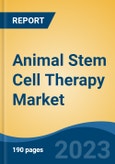Speak directly to the analyst to clarify any post sales queries you may have.
10% Free customizationThis report comes with 10% free customization, enabling you to add data that meets your specific business needs.
Key Market Drivers
Growth in Pet Ownership and Increased Animal Healthcare Expenditure
The global Animal Stem Cell Therapy Market is benefiting from robust growth driven by rising pet ownership and increased spending on animal healthcare. Over 50% of the global population is estimated to own pets, with households in the U.S., EU, and China collectively hosting more than 500 million dogs and cats. In the U.S., pet ownership has steadily increased, from 68% of households in 2016 to 70% in 2021, reflecting the growing importance of pets in family life. This trend presents substantial opportunities for industries focused on pet care, nutrition, and related services. Consumers are increasingly prioritizing pet-related products and services, particularly in advanced veterinary treatments such as stem cell therapy.The pet ownership trend continues to rise, especially in developed regions like North America, Europe, and parts of Asia-Pacific. Younger generations, including Millennials and Gen Z, are particularly likely to adopt pets as companions. A survey indicates that 45% of Gen Z and 40% of Millennials consider their pets the most important part of their lives, underlining a significant emotional and financial investment in pet care. In contrast, only 29% of older generations share this perspective, highlighting a generational shift in consumer behavior and spending patterns within the pet care industry.
Additionally, pets are increasingly seen as sources of emotional support, contributing to a growing demand for quality healthcare services. In the Asia-Pacific region, particularly in China, the pet humanization trend is on the rise, with 55% of pet owners considering their pets as children, and 28% regarding them as family members.
Key Market Challenges
Safety and Efficacy Concerns
Ensuring the safety and efficacy of stem cell therapies for animals remains a critical challenge. Although these therapies show significant promise, further research and clinical trials are necessary to establish their long-term safety and effectiveness for various medical conditions across different animal species.Key Market Players
- Ardent Animal Health
- Vet Stem Inc
- Medrego
- Vetbiologics
- VETHERAPY
- Celavie Biosciences
- Magellan Stem Cells
- Animal General
- Animal Cell Therapies, Inc.
- Cell Therapy Sciences Ltd
Report Scope
This report provides a comprehensive analysis of the global Animal Stem Cell Therapy Market, segmented as follows, with a detailed overview of industry trends:
By Type:
- Dogs Stem Cell Therapy
- Horses Stem Cell Therapy
By Application:
- Veterinary Hospitals
- Research Organizations
By Region:
- North America
- United States
- Canada
- Mexico
- Europe
- Germany
- United Kingdom
- France
- Italy
- Spain
- Asia-Pacific
- China
- Japan
- India
- Australia
- South Korea
- South America
- Brazil
- Argentina
- Colombia
- Middle East & Africa
- South Africa
- Saudi Arabia
- UAE
- Kuwait
Competitive Landscape and Company Profiles
The report provides an in-depth analysis of leading companies operating within the global Animal Stem Cell Therapy Market.Available Customizations
TechSci Research offers customizations tailored to a company's specific needs.This product will be delivered within 1-3 business days.
Table of Contents
Companies Mentioned
- Ardent Animal Health
- Vet Stem Inc
- Medrego
- Vetbiologics
- VETHERAPY
- Celavie Biosciences
- Magellan Stem Cells
- Animal General
- Animal Cell Therapies, Inc.
- Cell Therapy Sciences Ltd
Table Information
| Report Attribute | Details |
|---|---|
| No. of Pages | 180 |
| Published | February 2025 |
| Forecast Period | 2024 - 2030 |
| Estimated Market Value ( USD | $ 238.09 Million |
| Forecasted Market Value ( USD | $ 338.71 Million |
| Compound Annual Growth Rate | 6.0% |
| Regions Covered | Global |
| No. of Companies Mentioned | 10 |









